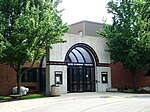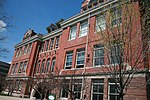Eastern Michigan University College of Arts and Sciences
| Established | 1959 |
|---|---|
| Dean | Dana A. Heller, Ph.D. |
| Location | , , |
| Nickname | CAS |
| Website | EMU CAS |
Eastern Michigan University College of Arts and Sciences is one of the Colleges at Eastern Michigan University. Today there are more than 125 programs of study in the College of Arts and Science.[1][2] The College of Arts and Sciences oversees the largest number of academic facilities and is the largest college at EMU.
History[]

The Eastern Michigan University College of Arts and Sciences was founded in 1959. The creation of the college was in the same year the school became Eastern Michigan University. As well, in 1959 the graduate school, the College of Arts and Sciences, and the College of Education. Today there are more than 125 programs of study in the College of Arts and Science.[1][2] The College of Arts and Sciences oversees the largest number of academic facilities and is the largest college at EMU. Office of the Dean of the College of Arts and many of the CAS departments are held within Pray-Harrold Hall.[3]
Facilities[]

The College of Arts and Sciences oversees facilities such as Ford Gallery, Pray-Harold, Sherzer Observatory, Kresge Environmental Education Center, the Terrestrial and Aquatic Ecology Research Facility, and Pease Auditorium. The Ford Gallery is where both students and practicing artists display works for the EMU community. The Sherzer Observatory which opened in 1978 is operated by Physics & Astronomy staff and student volunteers from the EMU Astronomy Club. The Kresege Environmental Education Center is a 240 acres (0.97 km2) facility near Lapeer, Michigan where research is conducted. The Terrestrial and Aquatic Ecology Research Facility was Constructed in 1998 and is operated by the Department of Biology. Lastly, Pease Auditorium opened in 1914 and has been "a cultural jewel in the heart of Ypsilanti".[4]

Departments[]
Eastern Michigan University College of Arts and Sciences consists of 15 Departments and 3 Schools.
|
|
Programs[]
The College of Arts and science has over 125 majors and minors. The school itself houses the most majors at EMU. Some of the notable CAS programs include the Historic Preservation program under the Department of Geography and Geology and the Forensics program under the School of Communication, Media and Theatre Arts.
Forensics[]
EMU is home to one of the nation's most successful forensics (competitive speech) teams. The EMU Forensics team, currently ranked 4th in the nation, has the distinction of being the only program in the country to place in the top 10 at every NFA national championship since they began in 1971.[5] The EMU forensics team has won 10 team national championships and 69 individual national championships. With 38 out of a possible 40 state championships, the team is the foremost forensics competitive team in the state of Michigan. This reputation has been enhanced by the fact that EMU competitors have won over 200 individual state championships.
Historic preservation[]
EMU's historic preservation program, in the Department of Geography and Geology, is the nation's largest historical preservation graduate program, and the only one in Michigan.[6][7] Founded in 1979 with support from a grant from the Preservation Education Fund of the National Trust for Historic Preservation, the program has won widespread recognition, including a Certificate of Commendation in 1989 from the American Association of State & Local History, co-hosting the Third Global Congress in Heritage Interpretation in 1991, hosting the 1997 meeting of the Pioneer America Society,[6][8][9] and the 2009 Michigan Historic Preservation Network Government/Institutional Award.[6][10] With the abolition of Michigan's Department of History, Arts, and Libraries, the EMU historic preservation program will take over preparation of text for the Michigan Historical Marker Program.[6][11][12]
Music[]
Teaching of music began at Michigan State Normal School in the second year of operation. In 1881, the State Board of Education authorized the creation of a Conservatory of Music, located on a site where Boone Hall now stands (across from the water tower, on cross st.). Because of this new modern building, the music program began to grow and thrive at Michigan State Normal School. When more music students came to learn and perform at MSNC, the administration decided that the conservatory of music was not sufficient anymore for the current demand the college was drawing for music. The board of regents hired Smith, Hinchman, & Grylls, Detroit to construct the building. After taking about three years to complete, Pease auditorium would now house musical events of all kinds. The music program continued to grow. The music program today has about 1,100 students at Eastern Michigan University and has classes in Alexander hall as well as .[13]
Accreditation[]
- School of Art & Design
- NASAD: National Association of Schools of Art and Design
- Department of Chemistry
- American Chemical Society (Professional Chemistry Curriculum)
- Department of Geography and Geology
- National Council for Preservation Education (Historic Preservation Programs)
- Planning Accreditation Board (Urban and Regional Planning)
- School of Music and Dance
- NASM: National Association of Schools of Music
- AMTA: American Music Therapy Association
- Department of Political Science
- National Association of Schools of Public Administration and Affairs
- Department of Psychology
- American Psychological Association - (PhD Clinical Psychology program)
- College-Wide Accreditations
- National Council for Accreditation of Teacher Education; State of Michigan
Notes[]
- ^ Jump up to: a b "Eastern Michigan University: College of Arts & Sciences".
- ^ Jump up to: a b "EMU CAS INFO". EMU CAS.
- ^ "pray harold facility". pray harold facility. emich.edu. Archived from the original on 28 January 2012. Retrieved 23 June 2011.
- ^ "Eastern Michigan University: College of Arts & Sciences".
- ^ 2010 NFA Results: http://cas.bethel.edu/dept/comm/nfa/2010team.html Archived 2012-07-10 at archive.today
- ^ Jump up to: a b c d Dettloff, Mary. "Department of Natural Resources historical landmarker program". Department of Natural Resources historical landmarker program. Department of Natural Resources. Retrieved 28 March 2012.
- ^ "New partnership forms to ensure future of Michigan Historical Marker Program". River Country Journal. 2010-02-18. Retrieved 2010-02-19.
EMU’s Historic Preservation Program is the largest graduate program in historic preservation in the nation, and the only such program in Michigan.
- ^ "Program History". Eastern Michigan University. Archived from the original on 2010-01-03. Retrieved 2010-02-19.
- ^ "EMU Historic Preservation". Eastern Michigan University. 2005-11-16. Retrieved 2010-02-19.
- ^ Heflin, Cindy (2009-06-24). "Eastern Michigan University wins historic preservation award". MLive.com. Retrieved 2010-02-20.
- ^ "About the Michigan Historical Marker Program". State of Michigan. 2011-02-20. Retrieved 2010-02-19.
- ^ "EMU takes on Michigan Historical Marker Program". WLNS. 2010-02-18. Retrieved 2010-02-19.
- ^ "Archived copy". Archived from the original on 2012-03-29. Retrieved 2011-12-28.CS1 maint: archived copy as title (link)
Coordinates: 42°14′58.5″N 83°37′21.3″W / 42.249583°N 83.622583°W
- Eastern Michigan University
- Liberal arts colleges in Michigan
- Modernist architecture in Michigan
- Educational institutions established in 1959
- 1959 establishments in Michigan




